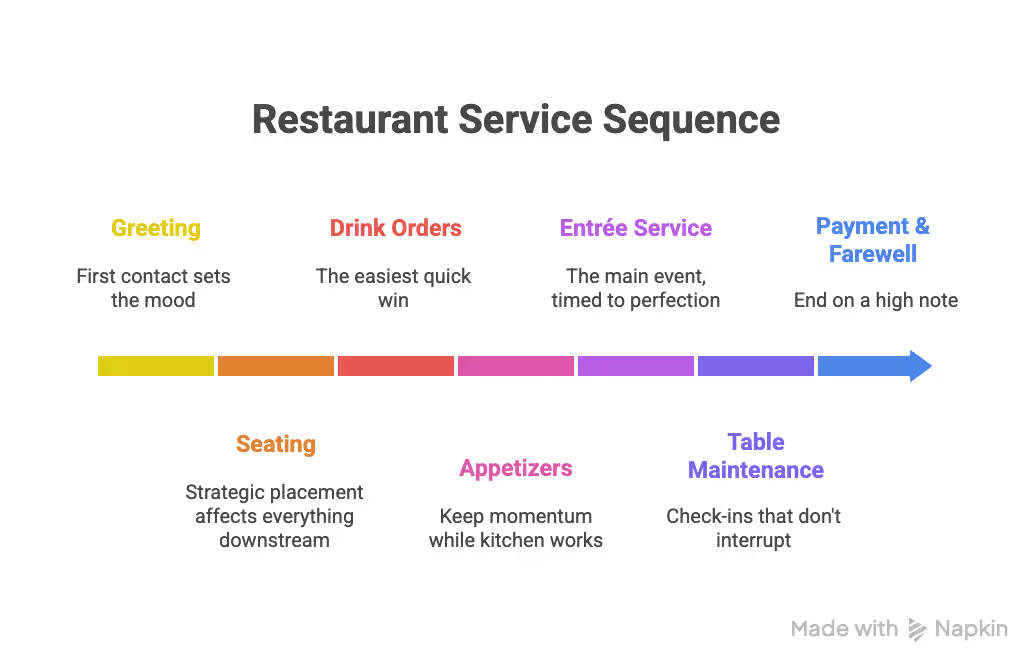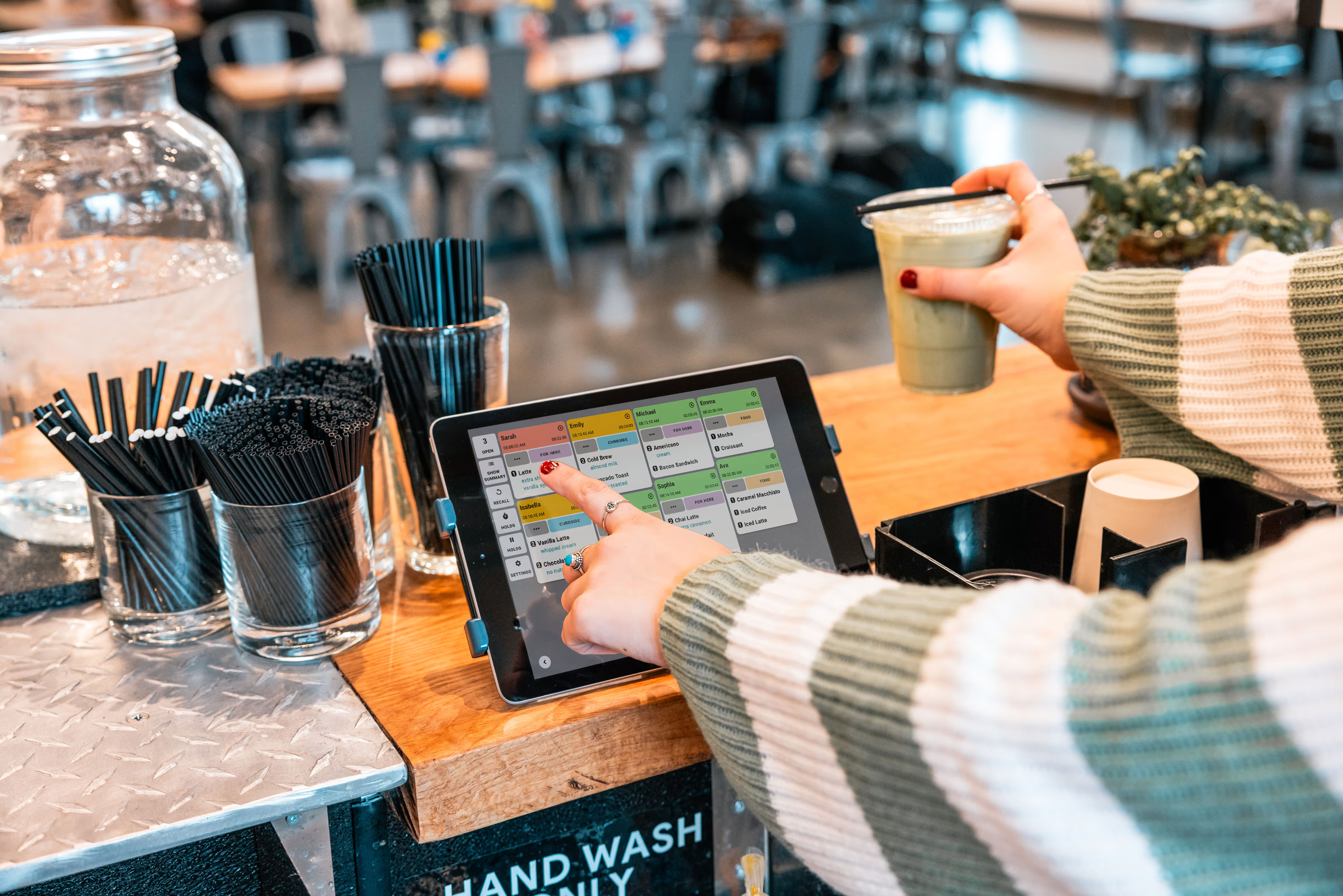The Clock Is Ticking (And So Are Your Customers)
Here's something I learned the hard way during my first restaurant gig: speed isn't just about rushing. It's about rhythm. And when that rhythm breaks down? You can practically hear the collective sigh of hungry diners checking their watches.
Think about it. You walk into a restaurant, stomach growling, expectations high. Then you wait. And wait. That initial excitement deflates like a sad soufflé. According to research on consumer behavior, the relationship between wait times and customer satisfaction isn't just important—it's everything. Speed of service directly impacts whether guests leave happy or hangry.
But here's the kicker: improving speed of service in a restaurant isn't about turning your dining room into a fast-food assembly line. It's about finding that sweet spot where efficiency meets experience.
Why Speed Matters More Than You Think
What is speed of service in a restaurant? It's the total time from when a customer places their order to when they receive their food—and everything in between. Greeting time, order-taking, kitchen prep, delivery, and even table clearing.
Why is speed important in a restaurant? Because time is the one ingredient you can never get back. Research shows that table turnover rates directly correlate with revenue potential. Faster service means more covers per shift, more money in the till. But it's not just about profit—it's about respect. Respecting your customers' time builds loyalty faster than any loyalty program ever could.
Look at the drive-thru data: Chick-fil-A leads customer satisfaction while Taco-Bell dominates speed metrics. The takeaway? You need both. Speed without quality is just rushed mediocrity. Quality without speed is a beautiful meal nobody has time to finish.

The Industry Rules You Need to Know
Let's talk benchmarks, because you can't improve what you don't measure.
What is the 30/30/30 rule for restaurants? Greet within 30 seconds, take the order within 30 seconds of greeting, and deliver drinks within 30 seconds after that. It's the rhythm that establishes momentum from the moment guests sit down.
What is the 80/20 rule in restaurants? The Pareto Principle suggests 80% of your revenue comes from 20% of your menu items. Smart operators use this to streamline prep, reduce waste, and speed up kitchen output.
What is the 5 second rule in restaurants? When a customer walks in, acknowledge them within five seconds. Even if you're slammed. This tiny gesture makes wait times feel shorter—which, psychologically, might be more important than actual wait times.
What does 86 mean in a restaurant? When an item is "86'd," it's off the menu. Communicating this quickly prevents orders that can't be fulfilled, saving time and avoiding delays.
What is the 201 rule in hospitality? Acknowledge guests within 20 seconds, seat them within 1 minute. First impressions happen fast.
The Seven Steps of Service (And How to Nail Each One)
What are the 7 steps of service in a restaurant?
- Greeting – First contact sets the mood
- Seating – Strategic placement affects everything downstream
- Drink Orders – The easiest quick win
- Appetizers – Keep momentum while kitchen works
- Entrée Service – The main event, timed to perfection
- Table Maintenance – Check-ins that don't interrupt
- Payment & Farewell – End on a high note
Each step is a potential bottleneck. How do you signal you're done at a restaurant? Silverware placement tells the story—knife and fork parallel at 4 o'clock means "I'm finished." Training staff to read these signals prevents awkward interruptions that slow table turns.
Who gets served first at a restaurant? Traditionally, women and elders first, then men, moving clockwise. But consistency matters more—when your team has a system, service flows faster.

Measuring What Matters
How to measure speed of service? Track these metrics religiously:
What is our speed of service time standard? This depends on your concept. Fast casual? 8-12 minutes from order to food. Fine dining? 90 minutes for a full experience. Quick service drive-thru? Industry leaders hit under 4 minutes total.
Know your lane, then dominate it.
How Can a Host Control the Flow of Their Restaurant?
The host stand is mission control. A skilled host orchestrates the entire dining room like a conductor leading an orchestra.
Strategic seating principles:
- Stagger tables – Don't slam one server's section all at once
- Know server strengths – Give faster servers the trickier tables
- Use waiting time wisely – Get drink orders at the bar
- Communicate constantly – Keep kitchen and servers in the loop
What are 5 methods of portion control? Portion control directly impacts speed—standardized portions mean faster plating, consistent cook times, and reduced waste. Use measuring tools, pre-portioned ingredients, standardized recipes, training, and regular audits.

The Drive-Thru Dilemma
How to improve drive-thru speed of service? The drive-thru is brutally transparent—customers can literally see the line not moving.
What is the time for drive-thru speed of service? Industry standard is 3-4 minutes from order speaker to window departure. Elite operators hit under 3 minutes consistently.
Winning strategies:
- Dual ordering lanes
- Outside order takers during peak times
- Simplified menus for faster decisions
- Pre-stage popular items
- Clear signage to reduce decision time
The Speed vs. Quality Paradox
How do you balance high quality service with speed? You can't balance them—you have to integrate them. Quality isn't a separate thing you add; it's built into your speed systems.
Quality ingredients prepped in advance. Training for muscle memory. Standardized recipes for consistency. Quality tools that work faster. Built-in quality checks at handoff points.
What is an example of speed of service in a restaurant? A server approaches within 20 seconds of seating. Takes drink order immediately. Drinks arrive within 2 minutes. Food order taken while guests sip. Kitchen gets the ticket in under 5 minutes. Food comes out 15 minutes later, perfectly plated. Total door-to-food time? Just over 20 minutes. That's efficient service that feels attentive, not rushed.
Customer Service Integration
How to improve speed in customer service? It's about emotional intelligence at velocity.
What are the 7 C's of customer service? Clear, Concise, Concrete, Correct, Coherent, Complete, and Courteous. Speed without warmth is just efficiency.
What are the 4 P's that improve customer service? Product (what you serve), Price (value perception), Place (atmosphere), and Promotion (how you communicate). When all four align, customers forgive minor speed hiccups.
What are three ways to improve customer service?
- Empower your staff to fix problems immediately
- Gather feedback systematically
- Invest in training – speed comes from competence
What are the 5 C's of customer service? Consistency, Competence, Communication, Courtesy, and Commitment to customer satisfaction.
Training for Speed
How to train your staff on customer service? Speed without training is chaos.
Role-playing scenarios until the seven steps are automatic. Shadow shifts where new staff follow your best servers. Video review of peak service times to spot bottlenecks. Checklists and standards for every position—"fast" is subjective, "greet within 30 seconds" is measurable.
How do you design a good service sequence? Think like a choreographer. Every movement should have purpose. Break complex processes into tiny, repeatable steps. The handoffs are where time gets lost.
What are the 12 steps of service? Some programs break service into detailed sequences—preparation, greeting, escorting, presenting menu, drinks, food order, appetizers, entrées, checking back, clearing, presenting check, farewell. The exact number matters less than the principle: every interaction is planned and optimized.
Real-World Implementation
How to be good service in a restaurant? Here's what separates good from great:
Anticipation – Refill water before it's empty. Awareness – Read the table's vibe. Accuracy – Get orders right the first time. Attitude – Rushed service with warmth beats slow service with indifference.
Can you suggest a few areas of improvement for our restaurant? Universal opportunities include: optimizing kitchen workflow, integrating technology like digital kitchen displays, menu engineering to eliminate bottlenecks, and strategic staff positioning during peak times.
The Ultimate Action Plan
Week 1: Measure Everything – Track current metrics, identify bottlenecks, shadow different positions.
Week 2: Quick Wins – Implement the 5-second greeting rule, pre-prep popular items, reorganize stations, install kitchen display systems.
Week 3: Training Blitz – Role-play service steps, practice transitions, conduct time trials, review footage.
Week 4: Refinement – Re-measure metrics, celebrate improvements, address remaining bottlenecks.
Ongoing: Culture Building – Speed of service isn't a project; it's a culture. The fastest restaurants aren't rushing—they're flowing.
The Bottom Line
I've seen restaurants transform by shaving just two minutes off average table time. Multiply that across 100 covers per night, and suddenly you're serving 10-15 more parties per shift. That's thousands in additional revenue per week.
But here's what matters more: those customers are happier. They're not checking their phones wondering when food will arrive. They're enjoying the experience. They're becoming regulars.
Speed of service isn't about rushing people out the door. It's about respecting their time while delivering an experience worth remembering. Master that balance, and you won't just have a faster restaurant—you'll have a better one.
Ready to take your restaurant's speed to the next level? Start by picking one metric to improve this week. Just one. Then build from there.







.png)




.webp)


